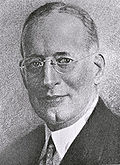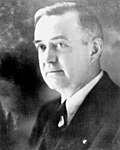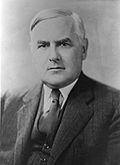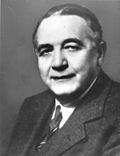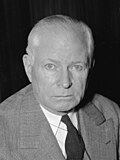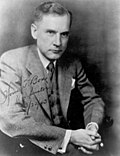Top Qs
Timeline
Chat
Perspective
1932 United States Senate elections
Clickable imagemap for the 1932 US Senate elections From Wikipedia, the free encyclopedia
Remove ads
The 1932 United States Senate elections coincided with Democrat Franklin D. Roosevelt's landslide victory over incumbent Herbert Hoover in the presidential election. The 32 seats of Class 3 were contested in regular elections, and special elections were held to fill vacancies.
With the Hoover administration widely blamed for the Great Depression, Republicans lost twelve seats and control of the chamber to the Democrats, who won 28 of the 34 contested races (two Democratic incumbents, Duncan U. Fletcher of Florida and John H. Overton of Louisiana, were re-elected unopposed). Democrats gained another seat through an appointment in Nebraska, bringing their total number of seats up to 60.
Among the Republican incumbents defeated in 1932 were Senate Majority Leader James Watson and five-term Senator Reed Smoot, an author of the controversial Smoot-Hawley tariff.[3] This was the first of four elections in which a Senate leader lost re-election, and the only time they were a Republican. This election marked the first time a woman was elected to the Senate, that being Hattie Caraway of Arkansas. As of 2024, this is the last time Democrats won a Senate election in Kansas.
This is also one of only five occasions where 10 or more Senate seats changed hands in an election, with the other occasions being in 1920, 1946, 1958, and 1980.
Remove ads
Gains, losses, and holds
Summarize
Perspective
Retirements
Three Democrats retired instead of seeking re-election.
Defeats
Eleven Republicans and three Democrats sought re-election but lost in the primary or general election.
Post-election changes
Remove ads
Change in composition
After the January special election
| D1 | D2 | D3 | D4 | D5 | D6 | D7 | D8 | ||
| D18 | D17 | D16 | D15 | D14 | D13 | D12 | D11 | D10 | D9 |
| D19 | D20 | D21 | D22 | D23 | D24 | D25 | D26 | D27 | D28 |
| D38 | D37 | D36 | D35 | D34 | D33 | D32 | D31 | D30 | D29 |
| D39 | D40 | D41 | D42 | D43 | D44 | D45 | D46 | D47 Ark. (sp) Elected[b] |
FL1 |
| Plurality → | R48 | ||||||||
| R39 | R40 | R41 | R42 | R43 | R44 | R45 | R46 | R47 | |
| R38 | R37 | R36 | R35 | R34 | R33 | R32 | R31 | R30 | R29 |
| R19 | R20 | R21 | R22 | R23 | R24 | R25 | R26 | R27 | R28 |
| R18 | R17 | R16 | R15 | R14 | R13 | R12 | R11 | R10 | R9 |
| R1 | R2 | R3 | R4 | R5 | R6 | R7 | R8 | ||
Before the November elections
| D1 | D2 | D3 | D4 | D5 | D6 | D7 | D8 | |||
| D18 | D17 | D16 | D15 | D14 | D13 | D12 | D11 | D10 | D9 | |
| D19 | D20 | D21 | D22 | D23 | D24 | D25 | D26 | D27 | D28 | |
| D38 Ga. (sp) Retired |
D37 Ga. (reg) Ran |
D36 Fla. Ran |
D35 Colo. (reg) Retired
|
D34 Ark. (reg) Ran |
D33 Ariz. Ran |
D32 Ala. Ran |
D31 | D30 | D29 | |
| D39 Kan. Ran |
D40 Ky. Ran |
D41 La. Ran |
D42 Md. Ran |
D43 Mo. Retired |
D44 N.Y. Ran |
D45 N.C. (reg) N.C. (sp) Ran |
D46 Ohio Ran |
D47 Okla. Ran |
D48 S.C. Ran | |
| Plurality → | ||||||||||
| FL1 | ||||||||||
| R39 N.J. (sp) Ran |
R40 N.D. Ran |
R41 Ore. Ran |
R42 Pa. Ran |
R43 S.D. Ran |
R44 Utah Ran |
R45 Vt. Ran |
R46 Wash. Ran |
R47 Wisc. Ran | ||
| R38 N.H. Ran |
R37 Nev. Ran |
R36 Iowa Ran |
R35 Ind. Ran |
R34 Ill. Ran |
R33 Idaho Ran |
R32 Conn. Ran |
R31 Calif. Ran |
R30 | R29 | |
| R19 | R20 | R21 | R22 | R23 | R24 | R25 | R26 | R27 | R28 | |
| R18 | R17 | R16 | R15 | R14 | R13 | R12 | R11 | R10 | R9 | |
| R1 | R2 | R3 | R4 | R5 | R6 | R7 | R8 | |||
Result of the November elections
| D1 | D2 | D3 | D4 | D5 | D6 | D7 | D8 | |||
| D18 | D17 | D16 | D15 | D14 | D13 | D12 | D11 | D10 | D9 | |
| D19 | D20 | D21 | D22 | D23 | D24 | D25 | D26 | D27 | D28 | |
| D38 Kan. Re-elected |
D37 Ga. (sp) Hold |
D36 Ga. (reg) Re-elected |
D35 Fla. Re-elected |
D34 Colo. (reg) Hold[c]
|
D33 Ark. (reg) Re-elected |
D32 Ariz. Re-elected |
D31 Ala. Re-elected |
D30 | D29 | |
| D39 Ky. Re-elected |
D40 La. Hold |
D41 Md. Re-elected |
D42 Mo. Hold |
D43 N.Y. Re-elected |
D44 N.C. (reg) N.C. (sp) Hold |
D45 Ohio Re-elected |
D46 Okla. Re-elected |
D47 S.C. Re-elected |
D48 Calif. Gain | |
| Majority → | D49 Conn. Gain | |||||||||
| D58 Wisc. Gain |
D57 Wash. Gain |
D56 Utah Gain |
D55 N.H. Gain |
D54 Nev. Gain |
D53 Iowa Gain |
D52 Ind. Gain |
D51 Ill. Gain |
D50 Idaho Gain | ||
| FL1 | R37 Vt. Re-elected |
R36 S.D. Re-elected |
R35 Pa. Re-elected |
R34 Ore. Re-elected |
R33 N.D. Re-elected |
R32 N.J. (sp) Elected[b] |
R31 | R30 | R29 | |
| R19 | R20 | R21 | R22 | R23 | R24 | R25 | R26 | R27 | R28 | |
| R18 | R17 | R16 | R15 | R14 | R13 | R12 | R11 | R10 | R9 | |
| R1 | R2 | R3 | R4 | R5 | R6 | R7 | R8 | |||
Remove ads
Race summary
Summarize
Perspective
All races are general elections for class 3 seats, unless noted.
Elections during the 72nd Congress
In these elections, the winners were elected and seated during 1932; ordered by election date.
Elections leading to the 73rd Congress
All elections are for Class 3 seats.
Remove ads
Closest races
Summarize
Perspective
Eleven races had a margin of victory under 10%:
New York was the tipping point state with a margin of 17.2%.
Remove ads
Alabama
Remove ads
Arizona
Remove ads
Arkansas
Summarize
Perspective
There were two elections for the same seat, due to the November 6, 1931 death of two-term Democrat Thaddeus H. Caraway.
Caraway's widow, Democrat Hattie Wyatt Caraway, was appointed November 13, 1931 to continue his term.
Arkansas (special)
Arkansas (regular)
In May 1932, Caraway surprised Arkansas politicians by announcing that she would run for a full term in the upcoming election, joining a field already crowded with prominent candidates who had assumed she would step aside. She told reporters, "The time has passed when a woman should be placed in a position and kept there only while someone else is being groomed for the job."[11] When she was invited by Vice President Charles Curtis to preside over the Senate she took advantage of the situation to announce that she would run for reelection. Populist former Governor and Senator Huey Long of neighboring Louisiana traveled to Arkansas on a seven-day campaign swing on her behalf. She was the first female senator to preside over the body as well as the first to chair a committee (Senate Committee on Enrolled Bills).[12] Lacking any significant political backing, Caraway accepted the offer of help from Long, whose efforts to limit incomes of the wealthy and increase aid to the poor she had supported. Long was also motivated by sympathy for the widow and his ambition to extend his influence into the home state of his party rival, Senator Joseph Robinson, who had been Al Smith's vice-presidential candidate in 1928. Bringing his colorful and flamboyant campaign style to Arkansas, Long stumped the state with Caraway for a week just before the Democratic primary. He helped her to amass nearly twice as many votes as her closest opponent.[13][page needed]
Long effectively used a method to quiet crying babies at campaign stops in Arkansas to encourage voter interest:
Mrs. Caraway would never forget nor cease to laugh over the plans we made for caring for obstreperous infants in the audience so that their mothers might listen to the speeches without the crowds being disturbed. I remember when I saw her notice one of our campaigners take charge of the first baby. The child began fretting and then began to cry. One of the young men accompanying us immediately gave it a drink of water. The child quieted for a bit and resumed a whimper, whereupon the same campaign worker handed the baby an all-day sucker, which it immediately grasped and soon fell asleep. Mrs. Caraway did not understand that it was a matter of design until it had been repeated several times.[14]
Caraway went on to win the general election in November, with the accompanying victory of Franklin D. Roosevelt as U.S. President.[13][page needed]
Remove ads
California
Remove ads
Colorado
Summarize
Perspective
There were two elections on November 8, 1932, for the same seat, due to the death of one-term Republican Charles W. Waterman. The primaries were held on September 13, 1932.[15][16]
Colorado (special)
Democrat Walter Walker was appointed to continue the term, pending the special election, which he then lost.
Republican attorney Karl C. Schuyler was elected to finish the term, but he lost the contemporaneous election to the next term. He died in 1933.[17]
Colorado (regular)
Democratic former senator Alva B. Adams was elected to start the new term that would begin in March 1933.
Adams would be re-elected once and serve until his December 1, 1941 death.
Remove ads
Connecticut
Remove ads
Florida
Remove ads
Georgia
Summarize
Perspective
There were two elections due to the death of William J. Harris. It was only the second time that both of Georgia's Senate seats have been up for election at the same time, following double-barrel elections in 1914.
Georgia (regular)
Georgia (special)

Democratic incumbent William J. Harris died April 18, 1932. Richard Russell Jr., the Democratic Governor of Georgia, appointed fellow-Democrat John S. Cohen April 25, 1932 to continue the term but Cohen was not a candidate for election.
Russell then won the September 14, 1932 Democratic primary over Representative Charles R. Crisp (nicknamed by Russell as "kilowatt Charlie" due to his links to the unpopular Georgia Power Company[20]), 57.72% to 42.28%.[21] Russell was then unopposed in the November 8, 1932 special election.[6]
Idaho
Illinois
Indiana
Iowa
Summarize
Perspective
Primaries were held on June 6, 1932.[23][24]
Murphy served only 3 years until his July 16, 1936 death.
Kansas
Kentucky
Louisiana
Maryland
Missouri
Nevada
New Hampshire
New Jersey (special)
New York
North Carolina
Summarize
Perspective
North Carolina (special)
Democratic former-Governor of North Carolina Cameron A. Morrison was appointed on December 13, 1930, to continue Overman's term, pending a special election. Primaries for both parties were held on June 4, 1932.[27][28][29] Morrison lost the primary run-off election.
Reynolds was seated December 5, 1932.
North Carolina (regular)
Primaries for both parties were held on June 4, 1932[30][31] and a Democratic run-off primary was held on July 2, 1932.[32] Interim appointee Cameron A. Morrison lost the primary run-off election.
Reynolds would be re-elected once and serve until his 1945 retirement.
North Dakota
44.85%
Ohio
Oklahoma
Oregon
Pennsylvania
South Carolina
South Dakota
Utah
Vermont
Washington
Wisconsin
See also
Notes
- The Democrats technically had 48 seats on election day, as Colorado's Democratic Governor Billy Adams had appointed Democrat Walter Walker at the end of September. But the Senate was not in session at any time before election day and therefore also not reorganized. Subsequently, the Republicans won the special election for the remainder of the term in the 72nd Congress.[1]
- Karl C. Schuyler (R) won the special election for the term ending in March 1933, but Alva B. Adams (D) won the general for the term beginning thereafter.
- Though Bone became senator-elect after the election, Jones's death left a vacancy which was filled by Elijah Sherman Grammer until Bone's term began in March.
References
Wikiwand - on
Seamless Wikipedia browsing. On steroids.
Remove ads


















